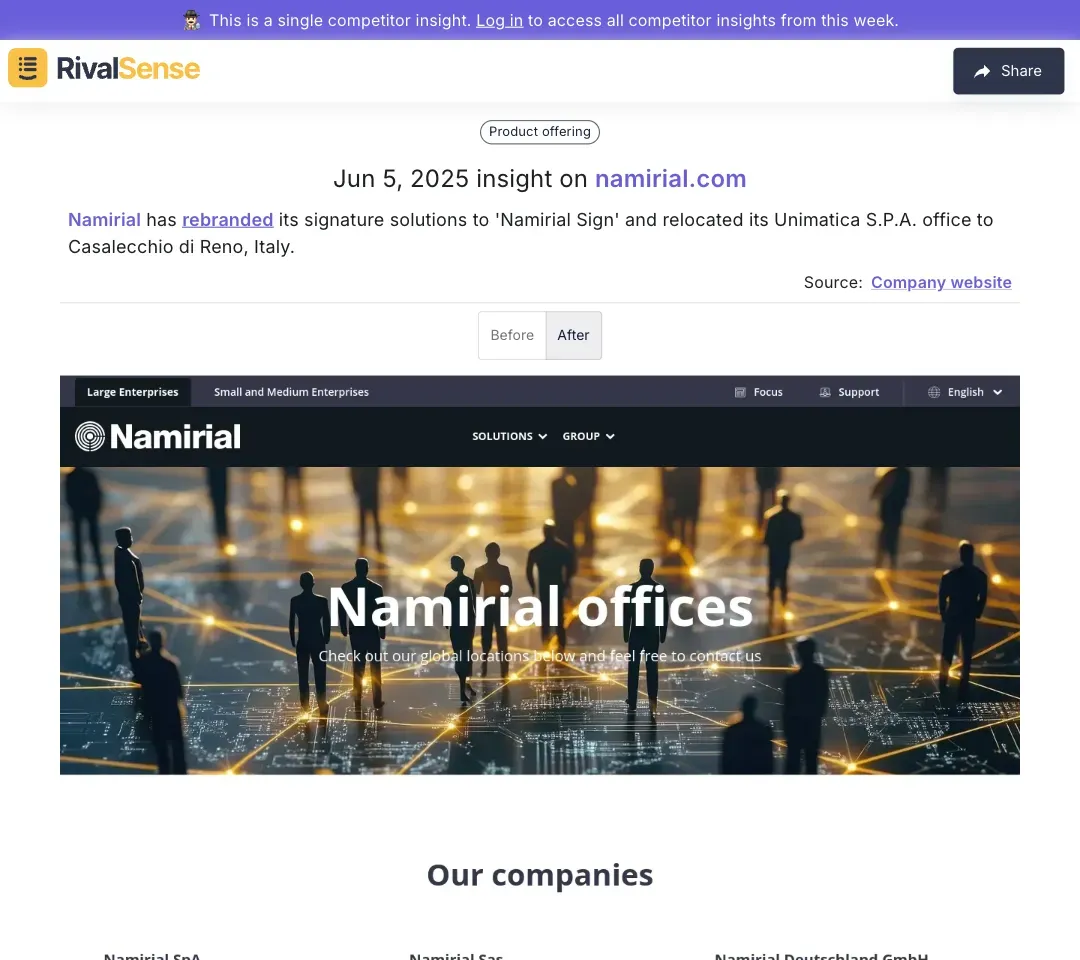How Namirial's Rebranding Shifted Competitor Strategies
Namirial's rebranding initiative marked a pivotal shift in its market strategy, aiming to modernize its image and expand its digital footprint. The objectives were clear: reflect its evolution from a traditional service provider to a cutting-edge digital solutions leader. Before the rebrand, Namirial was perceived as reliable but conventional, with strong roots in legacy systems.
For instance, competitive intelligence tools captured concrete details of this transformation: Namirial rebranded its signature solutions to 'Namirial Sign' and relocated its Unimatica S.P.A. office to Casalecchio di Reno, Italy.

Tracking such moves (rebranding + relocation) reveals strategic intent—signaling product consolidation and operational scaling. These insights help businesses anticipate market realignments and adjust positioning.
Initial industry reactions were mixed, with competitors initiating brand audits.
💡 Practical tip: Before rebranding, conduct competitor analysis to anticipate reactions.
✅ Checklist:
- Define clear rebrand objectives
- Assess current market perception
- Prepare contingency plans for feedback
Competitive Landscape Before the Rebranding 🌍
The digital trust services market pre-rebrand featured established players with distinct approaches. DocuSign prioritized global expansion and user-friendly e-signatures, while OneSpan emphasized security compliance. Namirial held a reliable but niche position, primarily in European digital transaction solutions.
Market trends like rising demand for eIDAS-compliant solutions pressured competitors to enhance offerings. Evicertia (Namirial's subsidiary) focused on electronic signatures, yet the broader landscape lacked aggressive innovation.
💡 Actionable advice: Continuously monitor competitor positioning to identify white-space opportunities.
✅ Checklist:
- Map key competitors' core capabilities
- Identify their geographic/service gaps
- Benchmark against regulatory trends
- Prioritize trust-building features
The Impact of Namirial's Rebranding on Competitors ⚡
Namirial's rebranding triggered immediate strategic countermoves across the DTM sector. Competitors like DocuSign and Adobe Acrobat Sign amplified messaging around global reach and compliance features. DocuSign accelerated integration capabilities, while Adobe highlighted UX and security enhancements.
Mid-sized players like Foxit eSign pivoted tactically—revamping pricing and UI to target small businesses, a segment Namirial's rebrand overlooked. This demonstrates how competitor shifts create secondary market opportunities.
💡 Strategic response framework:
- Track messaging shifts: Monitor website/press release changes
- Re-evaluate positioning: Compare offerings against rebranded features
- Leverage differentiators: Promote unique capabilities competitors can't replicate
✅ Post-rebrand monitoring checklist:
- [ ] Audit competitor websites quarterly
- [ ] Analyze social media engagement spikes
- [ ] Review pricing page updates
Long-Term Market Shifts Post-Rebranding 📈
Namirial's transformation catalyzed enduring changes beyond immediate reactions. The rebrand reset customer expectations around digital convenience and sustainability, forcing industry-wide innovation. Competitors responded by embedding eco-friendly practices and AI-driven features into core offerings.
Market dynamics shifted toward integrated solutions rather than standalone products. Competitors observed Namirial's enhanced digital engagement, sparking increased investment in omnichannel experiences. This evolution highlights how single-player rebrands can elevate sector standards.
💡 Sustainable adaptation tactics:
- Use social listening tools to detect preference shifts
- Allocate R&D budget to emerging tech (e.g., AI automation)
- Benchmark against rebrand-driven feature upgrades
Lessons Learned and Strategic Takeaways 🎓
Namirial's rebrand underscores that visual identity changes are merely the tip of the strategic iceberg. True transformation requires aligning internal operations with external positioning. One critical lesson: competitor reactions often reveal untapped market segments.
Effective response requires systematic monitoring. For example, tracking office relocations (like Namirial's move to Casalecchio di Reno) can signal geographic expansion plans—intelligence crucial for resource allocation.
💡 Rebrand response blueprint:
| Phase | Action | Competitive Advantage |
|---|---|---|
| Preparation | Map competitor weak spots | Identify positioning gaps |
| Launch | Monitor real-time reactions | Swift tactical adjustments |
| Consolidation | Analyze customer migration patterns | Retention strategy refinement |
✅ Post-rebrand checklist:
- [ ] Set Google Alerts for competitor keywords
- [ ] Conduct win/loss analysis with sales teams
- [ ] Audit competitor hiring trends for capability clues
Conclusion: Navigating the Ripple Effect 🌊
Namirial's rebranding demonstrates how single strategic moves can reshape entire markets. Competitors who adapted quickly gained advantage—whether through pricing adjustments, feature innovations, or segment targeting. Lasting success requires converting intelligence into action.
The most agile leaders don't just react; they anticipate. Continuous competitor monitoring turns market disruptions into opportunities. For real-time insights on moves like rebrands, office relocations, or pricing shifts:
Try RivalSense free → https://rivalsense.co/
Get your first competitor report today and transform market shifts into strategic advantages.
📚 Read more
👉 Harness LinkedIn for Market Intelligence: A Strategic Guide for B2B Leaders
👉 Workflow Breakdown: Market Research for Auto Glass Leaders
👉 How Competitor Hiring & Layoffs Reveal Financial Strategies
👉 Decoding Meta's Bangkok Training: Actionable Insights for Competitors
👉 How to Respond When Competitors Restructure: Multitude Case Study
